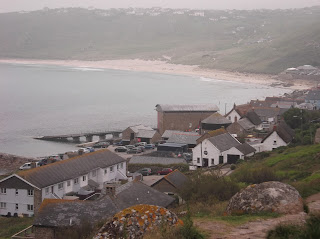Walk
154 Lands End to St Just (Cornwall)
(Third
leg of English coastal walk – Lands End to Bristol)
Map:
L/R 203
Distance:
9 miles or 13 km approx.
Difficulty:
Demanding with some easier parts
Terrain:
cliff coastal path with some road walking
Access:
Parking at both ends.
Public
transport: Buses from Penzance to Lands End and every hour from St
Just to Penzance.
Start
by exploring the buildings and features around Lands End. These
include Penwith House which was once a temperance hotel and is now a
gift shop. The famous sign, where you can have one finger-post
pointing to your own town and the distance to it, appears to be under
the control of an official photographer. The First and Last
Refreshment House is situated on the most south westerly point of
England. In Arthurian legend this spot is the halfway point between
Lands End and the Isles of Scilly and is where the mythical land of
Lyonesse was supposedly swallowed by the ocean.
The
fist headland along the coastal path from Lands End is Dr Syntax's
Head. It is thought that this may have been named after a 19th
century local school master and that the shape was like his chin! At
Pedn-men-du is a 19th century coastguard look out built on
the craggy rocks. The path drops down a road and then into Sennen
Cove which is at the southern end of Whitesand Bay. It is very
popular with surfers. It was also home to the first canine lifeguard
in the UK, a dog called Bilbo. He was active between 2005-2007 and
there have been petitions to bring him back. I noticed a member of
the RNLI checking on the safety of surfers on his quadbike. One of
the more popular duties I would think.
On
the walk to Cape Cornwall there are several warnings of exposed old
tin mine shafts. It is strongly advised that you keep to the path
unless you want to risk disappearing without trace. The cape (the
only one so named in England) is the second most westerly point in
the UK and is capped by an old mining tower. The area is owned by the
National Trust so all of the cape can be explored. Out at sea, on the
south side, are The Brisons. In 1851, the ship,The New Commercial, ended up on
these rocks but the captain and his wife remained on board until the
crew were rescued. They were both pulled off but, unfortunately, the
wife died before reaching the shore.
Follow
the walk around past a few old tin mine chimneys then take one of the
roads or paths into St Just.
Photos show: Sennen Cove and Whitesand Bay; Cape Cornwall.




























